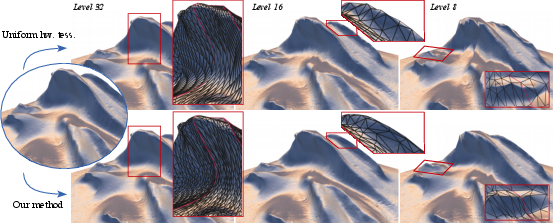Section: New Results
Rendering, Visualization and Illustration
Cache-friendly Sampling
Monte-Carlo integration techniques for global illumination are popular on GPUs thanks to their massive parallel architecture, but efficient implementation remains challenging. The use of randomly de-correlated low-discrepancy sequences in the path-tracing algorithm allows faster visual convergence. However, the parallel tracing of incoherent rays often results in poor memory cache utilization, reducing the ray bandwidth efficiency. Interleaved sampling [65] partially solves this problem, by using a small set of distributions split in coherent ray-tracing passes, but the solution is prone to structured noise. On the other hand, ray-reordering methods [83] group stochastic rays into coherent ray packets but their implementation add an additional sorting cost on the GPU [74], [50]. We have introduced [19] a micro-jittering technique for faster multi-dimensional Monte-Carlo integration in ray-based rendering engines. Our method, improves ray coherency between GPU threads using a slightly altered low-discrepancy sequence rather than using ray-reordering methods. Compatible with any low-discrepancy sequence and independent of the importance sampling strategy, our method achieves comparable visual quality with classic de-correlation methods, like Cranley-Patterson rotation [66], while reducing rendering times in all scenarios.
Multi-Resolution Meshes for Feature-Aware Hardware Tessellation
|
Hardware tessellation is de facto the preferred mechanism to adaptively control mesh resolution with maximal performances. However, owing to its fixed and uniform pattern, leveraging tessellation for feature-aware LOD rendering remains a challenging problem. In [15], we relax this fundamental constraint by introducing a new spatial and temporal blending mechanism of tessellation levels, which is built on top of a novel hierarchical representation of multi-resolution meshes. This mechanism allows to finely control topological changes so that vertices can be removed or added at the most appropriate location to preserve geometric features in a continuous and artifact-free manner (cf. Figure 9). We then show how to extend edge-collapse based decimation methods to build feature-aware multi-resolution meshes that match the tessellation patterns. Our approach is fully compatible with current hardware tessellators and only adds a small overhead on memory consumption and tessellation cost. This work as been published at Eurographics 2016 [15].
Shape Depiction for Transparent Objects
Shading techniques are useful to deliver a better understanding of object shapes. When transparent objects are involved, depicting the shape characteristics of each surface is even more relevant. We have developed [21] a method for rendering transparent scenes or objects using classical tools for shape depiction in real time. Our method provides an efficient way to compute screen space curvature on transparent objects by using a novel screen space representation of a scene derived from Order Independent Transparency techniques. Moreover, we propose a customizable stylization that modulates the transparency per fragment, according to its curvature and its depth, which can be adapted for various kinds of applications.



